Explorers Find Passage to Earth’s Dark Age
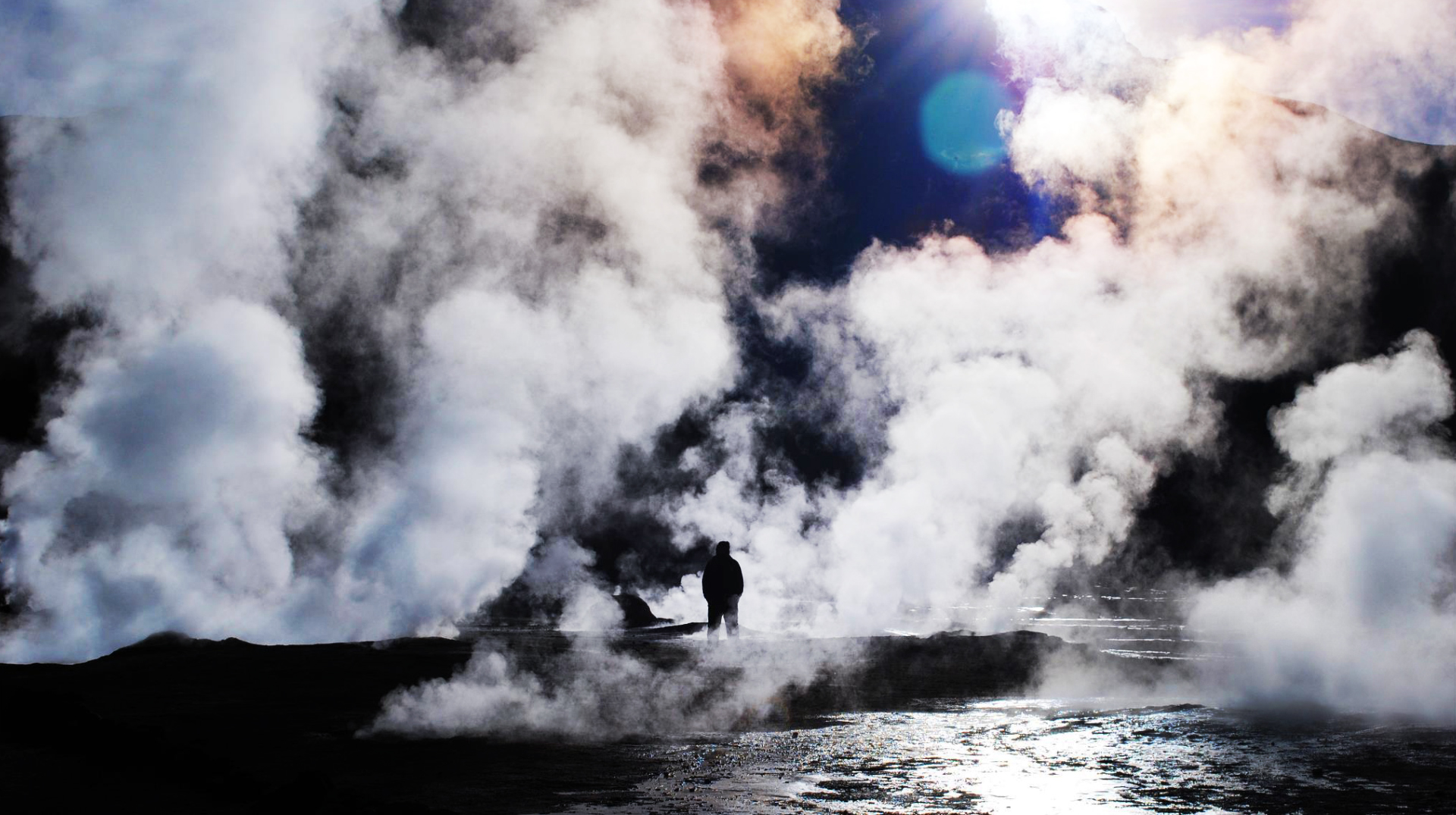
Earth scientists hope that their growing knowledge of the planet’s early history will shed light on poorly understood features seen today, from continents to geysers.
Eric King
Introduction
In August, the geologist Matt Jackson left California with his wife and 4-year-old daughter for the fjords of northwest Iceland, where they camped as he roamed the outcrops and scree slopes by day in search of little olive-green stones called olivine.
A sunny young professor at the University of California, Santa Barbara, with a uniform of pearl-snap shirts and well-utilized cargo shorts, Jackson knew all the best hunting grounds, having first explored the Icelandic fjords two years ago. Following sketchy field notes handed down by earlier geologists, he covered 10 or 15 miles a day, past countless sheep and the occasional farmer. “Their whole lives they’ve lived in these beautiful fjords,” he said. “They look up to these black, layered rocks, and I tell them that each one of those is a different volcanic eruption with a lava flow. It blows their minds!” He laughed. “It blows my mind even more that they never realized it!”
The olivine erupted to Earth’s surface in those very lava flows between 10 and 17 million years ago. Jackson, like many geologists, believes that the source of the eruptions was the Iceland plume, a hypothetical upwelling of solid rock that may rise, like the globules in a lava lamp, from deep inside Earth. The plume, if it exists, would now underlie the active volcanoes of central Iceland. In the past, it would have surfaced here at the fjords, back in the days when here was there — before the puzzle-piece of Earth’s crust upon which Iceland lies scraped to the northwest.
Other modern findings about olivine from the region suggest that it might derive from an ancient reservoir of minerals at the base of the Iceland plume that, over billions of years, never mixed with the rest of Earth’s interior. Jackson hoped the samples he collected would carry a chemical message from the reservoir and prove that it formed during the planet’s infancy — a period that until recently was inaccessible to science.

On the Moon’s Far Side, Clues to a Cataclysm?
After returning to California, he sent his samples to Richard Walker to ferret out that message. Walker, a geochemist at the University of Maryland, is processing the olivine to determine the concentration of the chemical isotope tungsten-182 in the rock relative to the more common isotope, tungsten-184. If Jackson is right, his samples will join a growing collection of rocks from around the world whose abnormal tungsten isotope ratios have completely surprised scientists. These tungsten anomalies reflect processes that could only have occurred within the first 50 million years of the solar system’s history, a formative period long assumed to have been wiped from the geochemical record by cataclysmic collisions that melted Earth and blended its contents.
The anomalies “are giving us information about some of the earliest Earth processes,” Walker said. “It’s an alternative universe from what geochemists have been working with for the past 50 years.”
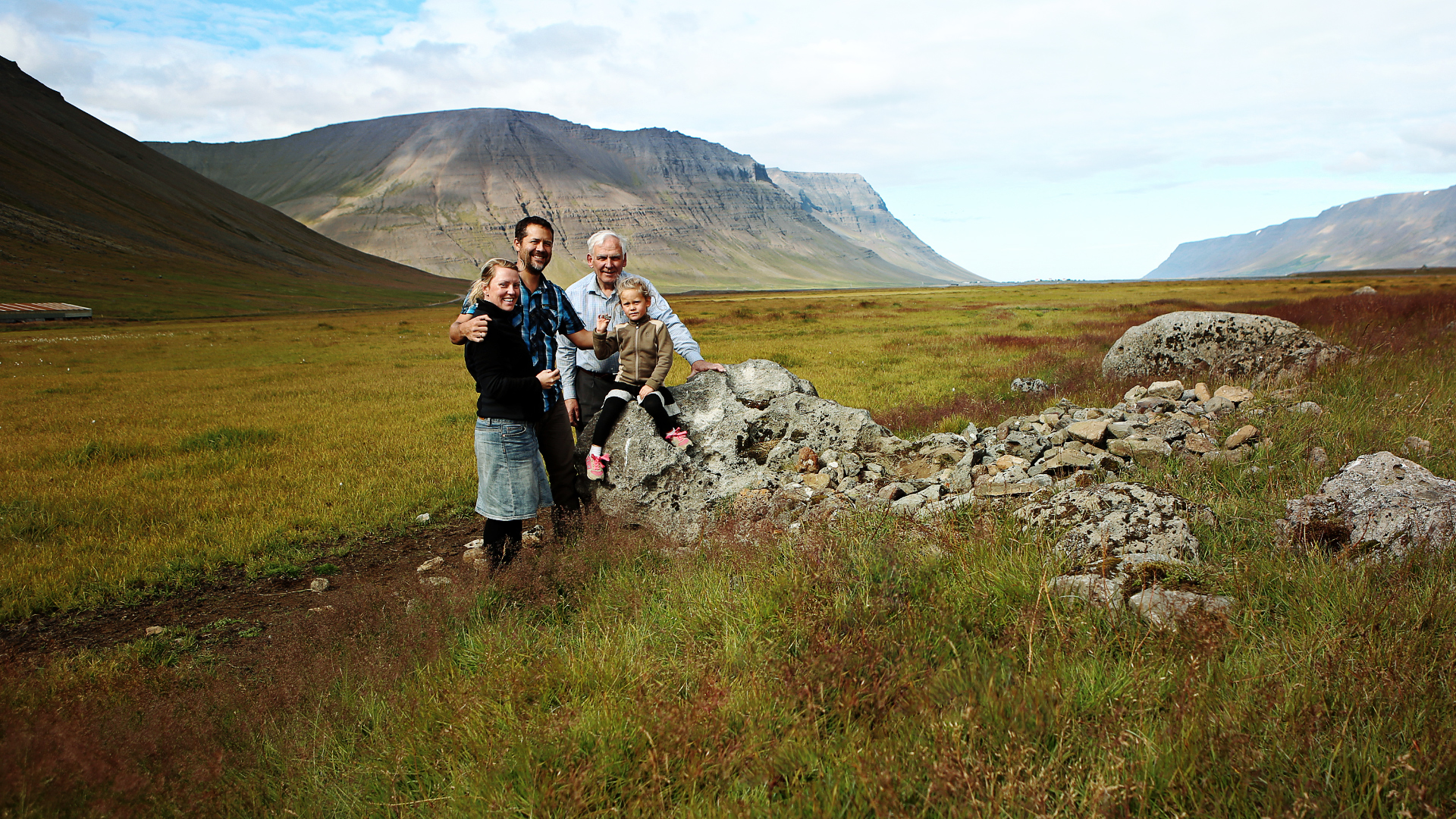
Matt Jackson and his family with a local farmer in northwest Iceland.
Courtesy of Matt Jackson
The discoveries are sending geologists like Jackson into the field in search of more clues to Earth’s formation — and how the planet works today. Modern Earth, like early Earth, remains poorly understood, with unanswered questions ranging from how volcanoes work and whether plumes really exist to where oceans and continents came from, and what the nature and origin might be of the enormous structures, colloquially known as “blobs,” that seismologists detect deep down near Earth’s core. All aspects of the planet’s form and function are interconnected. They’re also entangled with the rest of the solar system. Any attempt, for instance, to explain why tectonic plates cover Earth’s surface like a jigsaw puzzle must account for the fact that no other planet in the solar system has plates. To understand Earth, scientists must figure out how, in the context of the solar system, it became uniquely earthlike. And that means probing the mystery of the first tens of millions of years.
“You can think about this as an initial-conditions problem,” said Michael Manga, a geophysicist at the University of California, Berkeley, who studies geysers and volcanoes. “The Earth we see today evolved from something. And there’s lots of uncertainty about what that initial something was.”
Pieces of the Puzzle
On one of an unbroken string of 75-degree days in Santa Barbara the week before Jackson left for Iceland, he led a group of earth scientists on a two-mile beach hike to see some tar dikes — places where the sticky black material has oozed out of the cliff face at the back of the beach, forming flabby, voluptuous folds of faux rock that you can dent with a finger. The scientists pressed on the tar’s wrinkles and slammed rocks against it, speculating about its subterranean origin and the ballpark range of its viscosity. When this reporter picked up a small tar boulder to feel how light it was, two or three people nodded approvingly.
A mix of geophysicists, geologists, mineralogists, geochemists and seismologists, the group was in Santa Barbara for the annual Cooperative Institute for Dynamic Earth Research (CIDER) workshop at the Kavli Institute for Theoretical Physics. Each summer, a rotating cast of representatives from these fields meet for several weeks at CIDER to share their latest results and cross-pollinate ideas — a necessity when the goal is understanding a system as complex as Earth.
Earth’s complexity, how special it is, and, above all, the black box of its initial conditions have meant that, even as cosmologists map the universe and astronomers scan the galaxy for Earth 2.0, progress in understanding our home planet has been surprisingly slow. As we trudged from one tar dike to another, Jackson pointed out the exposed sedimentary rock layers in the cliff face — some of them horizontal, others buckled and sloped. Amazingly, he said, it took until the 1960s for scientists to even agree that sloped sediment layers are buckled, rather than having piled up on an angle. Only then was consensus reached on a mechanism to explain the buckling and the ruggedness of Earth’s surface in general: the theory of plate tectonics.
Projecting her voice over the wind and waves, Carolina Lithgow-Bertelloni, a geophysicist from University College London who studies tectonic plates, credited the German meteorologist Alfred Wegener for first floating the notion of continental drift in 1912 to explain why Earth’s landmasses resemble the dispersed pieces of a puzzle. “But he didn’t have a mechanism — well, he did, but it was crazy,” she said.
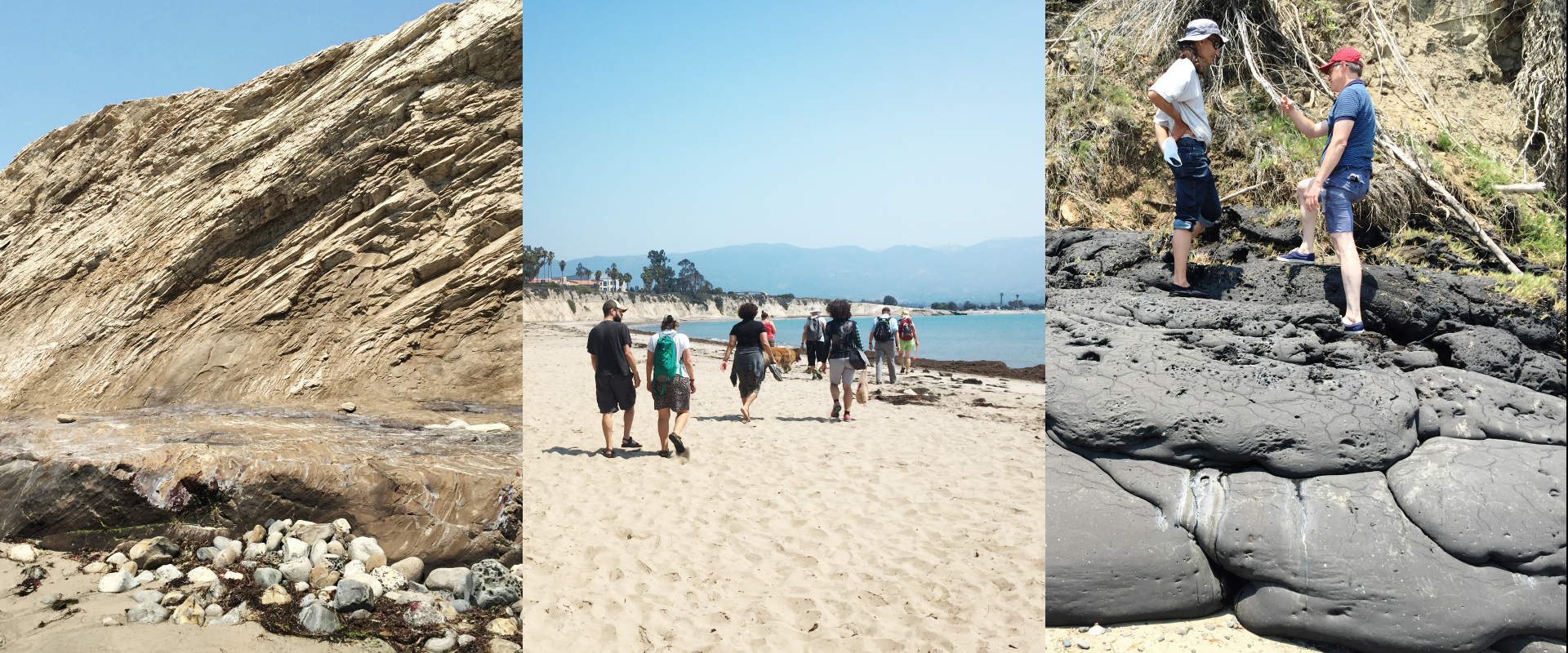
Earth scientists on a beach hike in Santa Barbara County, California.
Natalie Wolchover/Quanta Magazine
A few years later, she continued, the British geologist Sir Arthur Holmes convincingly argued that Earth’s solid-rock mantle flows fluidly on geological timescales, driven by heat radiating from Earth’s core; he speculated that this mantle flow in turn drives surface motion. More clues came during World War II. Seafloor magnetism, mapped for the purpose of hiding submarines, suggested that new crust forms at the mid-ocean ridge — the underwater mountain range that lines the world ocean like a seam — and spreads in both directions to the shores of the continents. There, at “subduction zones,” the oceanic plates slide stiffly beneath the continental plates, triggering earthquakes and carrying water downward, where it melts pockets of the mantle. This melting produces magma that rises to the surface in little-understood fits and starts, causing volcanic eruptions. (Volcanoes also exist far from any plate boundaries, such as in Hawaii and Iceland. Scientists currently explain this by invoking the existence of plumes, which researchers like Walker and Jackson are starting to verify and map using isotope studies.)
The physical description of the plates finally came together in the late 1960s, Lithgow-Bertelloni said, when the British geophysicist Dan McKenzie and the American Jason Morgan separately proposed a quantitative framework for modeling plate tectonics on a sphere.
Other than their existence, almost everything about the plates remains in contention. For instance, what drives their lateral motion? Where do subducted plates end up — perhaps these are the blobs? — and how do they affect Earth’s interior dynamics? Why did Earth’s crust shatter into plates in the first place when no other planetary surface in the solar system did? Also completely mysterious is the two-tier architecture of oceanic and continental plates, and how oceans and continents came to ride on them — all possible prerequisites for intelligent life. Knowing more about how Earth became earthlike could help us understand how common earthlike planets are in the universe and thus how likely life is to arise.
The continents probably formed, Lithgow-Bertelloni said, as part of the early process by which gravity organized Earth’s contents into concentric layers: Iron and other metals sank to the center, forming the core, while rocky silicates stayed in the mantle. Meanwhile, low-density materials buoyed upward, forming a crust on the surface of the mantle like soup scum. Perhaps this scum accumulated in some places to form continents, while elsewhere oceans materialized.
Figuring out precisely what happened and the sequence of all of these steps is “more difficult,” Lithgow-Bertelloni said, because they predate the rock record and are “part of the melting process that happens early on in Earth’s history — very early on.”
Until recently, scientists knew of no geochemical traces from so long ago, and they thought they might never crack open the black box from which Earth’s most glorious features emerged. But the subtle anomalies in tungsten and other isotope concentrations are now providing the first glimpses of the planet’s formation and differentiation. These chemical tracers promise to yield a combination timeline-and-map of early Earth, revealing where its features came from, why, and when.
A Sketchy Timeline
Humankind’s understanding of early Earth took its first giant leap when Apollo astronauts brought back rocks from the moon: our tectonic-less companion whose origin was, at the time, a complete mystery.
The rocks “looked gray, very much like terrestrial rocks,” said Fouad Tera, who analyzed lunar samples at the California Institute of Technology between 1969 and 1976. But because they were from the moon, he said, they created “a feeling of euphoria” in their handlers. Some interesting features did eventually show up: “We found glass spherules — colorful, beautiful — under the microscope, green and yellow and orange and everything,” recalled Tera, now 85. The spherules probably came from fountains that gushed from volcanic vents when the moon was young. But for the most part, he said, “the moon is not really made out of a pleasing thing — just regular things.”
In hindsight, this is not surprising: Chemical analysis at Caltech and other labs indicated that the moon formed from Earth material, which appears to have gotten knocked into orbit when the 60 to 100 million-year-old proto-Earth collided with another protoplanet in the crowded inner solar system. This “giant impact” hypothesis of the moon’s formation, though still hotly debated in its particulars, established a key step on the timeline of the Earth, moon and sun that has helped other steps fall into place.

Panorama of the Taurus-Littrow valley created from photographs by Apollo 17 astronaut Eugene Cernan. Fellow astronaut Harrison Schmitt is shown using a rake to collect samples.
NASA
Chemical analysis of meteorites is helping scientists outline even earlier stages of our solar system’s timeline, including the moment it all began.
First, 4.57 billion years ago, a nearby star went supernova, spewing matter and a shock wave into space. The matter included radioactive elements that immediately began decaying, starting the clocks that isotope chemists now measure with great precision. As the shock wave swept through our cosmic neighborhood, it corralled the local cloud of gas and dust like a broom; the increase in density caused the cloud to gravitationally collapse, forming a brand-new star — our sun — surrounded by a placenta of hot debris.
Over the next tens of millions of years, the rubble field surrounding the sun clumped into bigger and bigger space rocks, then accreted into planet parts called “planetesimals,” which merged into protoplanets, which became Mercury, Venus, Earth and Mars — the four rocky planets of the inner solar system today. Farther out, in colder climes, gas and ice accreted into the giant planets.
As the infant Earth navigated the crowded inner solar system, it would have experienced frequent, white-hot collisions, which were long assumed to have melted the entire planet into a global “magma ocean.” During these melts, gravity differentiated Earth’s liquefied contents into layers — core, mantle and crust. It’s thought that each of the global melts would have destroyed existing rocks, blending their contents and removing any signs of geochemical differences left over from Earth’s initial building blocks.
The last of the Earth-melting “giant impacts” appears to have been the one that formed the moon; while subtracting the moon’s mass, the impactor was also the last major addition to Earth’s mass. Perhaps, then, this point on the timeline — at least 60 million years after the birth of the solar system and, counting backward from the present, at most 4.51 billion years ago — was when the geochemical record of the planet’s past was allowed to begin. “It’s at least a compelling idea to think that this giant impact that disrupted a lot of the Earth is the starting time for geochronology,” said Rick Carlson, a geochemist at the Carnegie Institution of Washington. In those first 60 million years, “the Earth may have been here, but we don’t have any record of it because it was just erased.”
Another discovery from the moon rocks came in 1974. Tera, along with his colleague Dimitri Papanastassiou and their boss, Gerry Wasserburg, a towering figure in isotope cosmochemistry who died in June, combined many isotope analyses of rocks from different Apollo missions on a single plot, revealing a straight line called an “isochron” that corresponds to time. “When we plotted our data along with everybody else’s, there was a distinct trend that shows you that around 3.9 billion years ago, something massive imprinted on all the rocks on the moon,” Tera said.
Wasserburg dubbed the event the “lunar cataclysm.” Now more often called the “late heavy bombardment,” it was a torrent of asteroids and comets that seems to have battered the moon 3.9 billion years ago, a full 600 million years after its formation, melting and chemically resetting the rocks on its surface. The late heavy bombardment surely would have rained down even more heavily on Earth, considering the planet’s greater size and gravitational pull. Having discovered such a momentous event in solar system history, Wasserburg left his younger, more reserved colleagues behind and “celebrated in Pasadena in some bar,” Tera said.
As of 1974, no rocks had been found on Earth from the time of the late heavy bombardment. In fact, Earth’s oldest rocks appeared to top out at 3.8 billion years. “That number jumps out at you,” said Bill Bottke, a planetary scientist at the Southwest Research Institute in Boulder, Colorado. It suggests, Bottke said, that the late heavy bombardment might have melted whatever planetary crust existed 3.9 billion years ago, once again destroying the existing geologic record, after which the new crust took 100 million years to harden.
In 2005, a group of researchers working in Nice, France, conceived of a mechanism to explain the late heavy bombardment — and several other mysteries about the solar system, including the curious configurations of Jupiter, Saturn, Uranus and Neptune, and the sparseness of the asteroid and Kuiper belts. Their “Nice model” posits that the gas and ice giants suddenly destabilized in their orbits sometime after formation, causing them to migrate. Simulations by Bottke and others indicate that the planets’ migrations would have sent asteroids and comets scattering, initiating something very much like the late heavy bombardment. Comets that were slung inward from the Kuiper belt during this shake-up might even have delivered water to Earth’s surface, explaining the presence of its oceans.
With this convergence of ideas, the late heavy bombardment became widely accepted as a major step on the timeline of the early solar system. But it was bad news for earth scientists, suggesting that Earth’s geochemical record began not at the beginning, 4.57 billion years ago, or even at the moon’s beginning, 4.51 billion years ago, but 3.8 billion years ago, and that most or all clues about earlier times were forever lost.
Extending the Rock Record
More recently, the late heavy bombardment theory and many other long-standing assumptions about the early history of Earth and the solar system have come into question, and Earth’s dark age has started to come into the light. According to Carlson, “the evidence for this 3.9 [billion-years-ago] event is getting less clear with time.” For instance, when meteorites are analyzed for signs of shock, “they show a lot of impact events at 4.2, 4.4 billion,” he said. “This 3.9 billion event doesn’t show up really strong in the meteorite record.” He and other skeptics of the late heavy bombardment argue that the Apollo samples might have been biased. All the missions landed on the near side of the moon, many in close proximity to the Imbrium basin (the moon’s biggest shadow, as seen from Earth), which formed from a collision 3.9 billion years ago. Perhaps all the Apollo rocks were affected by that one event, which might have dispersed the melt from the impact over a broad swath of the lunar surface. This would suggest a cataclysm that never occurred.
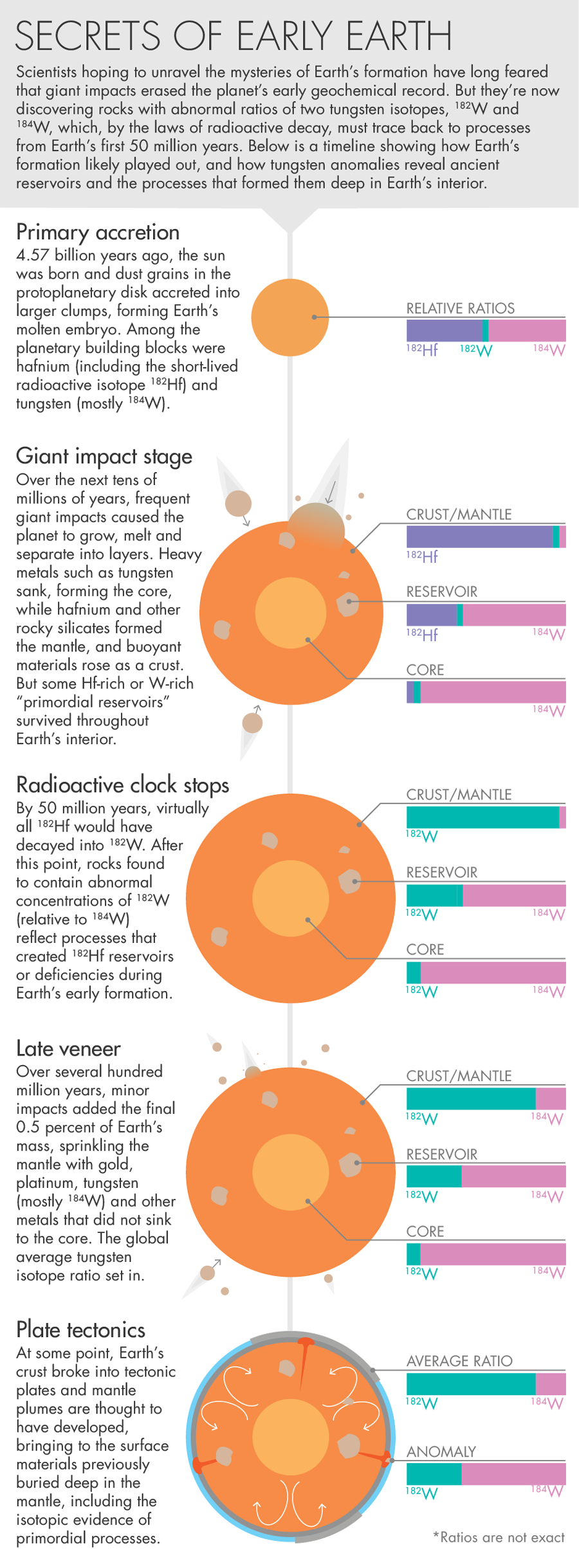

Lucy Reading-Ikkanda/Quanta Magazine
Furthermore, the oldest known crust on Earth is no longer 3.8 billion years old. Rocks have been found in two parts of Canada dating to 4 billion and an alleged 4.28 billion years ago, refuting the idea that the late heavy bombardment fully melted Earth’s mantle and crust 3.9 billion years ago. At least some earlier crust survived.
In 2008, Carlson and collaborators reported the evidence of 4.28 billion-year-old rocks in the Nuvvuagittuq greenstone belt in Canada. When Tim Elliott, a geochemist at the University of Bristol, read about the Nuvvuagittuq findings, he was intrigued to see that Carlson had used a dating method also used in earlier work by French researchers that relied on a short-lived radioactive isotope system called samarium-neodymium. Elliott decided to look for traces of an even shorter-lived system — hafnium-tungsten — in ancient rocks, which would point back to even earlier times in Earth’s history.
The dating method works as follows: Hafnium-182, the “parent” isotope, has a 50 percent chance of decaying into tungsten-182, its “daughter,” every 9 million years (this is the parent’s “half-life”). The halving quickly reduces the parent to almost nothing; by 50 million years after the supernova that sparked the sun, virtually all the hafnium-182 would have become tungsten-182.
That’s why the tungsten isotope ratio in rocks like Matt Jackson’s olivine samples can be so revealing: Any variation in the concentration of the daughter isotope, tungsten-182, measured relative to tungsten-184 must reflect processes that affected the parent, hafnium-182, when it was around — processes that occurred during the first 50 million years of solar system history. Elliott knew that this kind of geochemical information was previously believed to have been destroyed by early Earth melts and billions of years of subsequent mantle convection. But what if it wasn’t?
Elliott contacted Stephen Moorbath, then an emeritus professor of geology at the University of Oxford and “one of the grandfather figures in finding the oldest rocks,” Elliott said. Moorbath “was keen, so I took the train up.” Moorbath led Elliott down to the basement of Oxford’s earth science building, where, as in many such buildings, a large collection of rocks shares the space with the boiler and stacks of chairs. Moorbath dug out specimens from the Isua complex in Greenland, an ancient bit of crust that he had pegged, in the 1970s, at 3.8 billion years old.
Elliott and his student Matthias Willbold powdered and processed the Isua samples and used painstaking chemical methods to extract the tungsten. They then measured the tungsten isotope ratio using state-of-the-art mass spectrometers. In a 2011 Nature paper, Elliott, Willbold and Moorbath, who died in October, reported that the 3.8 billion-year-old Isua rocks contained 15 parts per million more tungsten-182 than the world average — the first ever detection of a “positive” tungsten anomaly on the face of the Earth.
The paper scooped Richard Walker of Maryland and his colleagues, who months later reported a positive tungsten anomaly in 2.8 billion-year-old komatiites from Kostomuksha, Russia.
Although the Isua and Kostomuksha rocks formed on Earth’s surface long after the extinction of hafnium-182, they apparently derive from materials with much older chemical signatures. Walker and colleagues argue that the Kostomuksha rocks must have drawn from hafnium-rich “primordial reservoirs” in the interior that failed to homogenize during Earth’s early mantle melts. The preservation of these reservoirs, which must trace to the first 50 million years and must somehow have survived even the moon-forming impact, “indicates that the mantle may have never been well mixed,” Walker and his co-authors wrote. That raises the possibility of finding many more remnants of Earth’s early history.
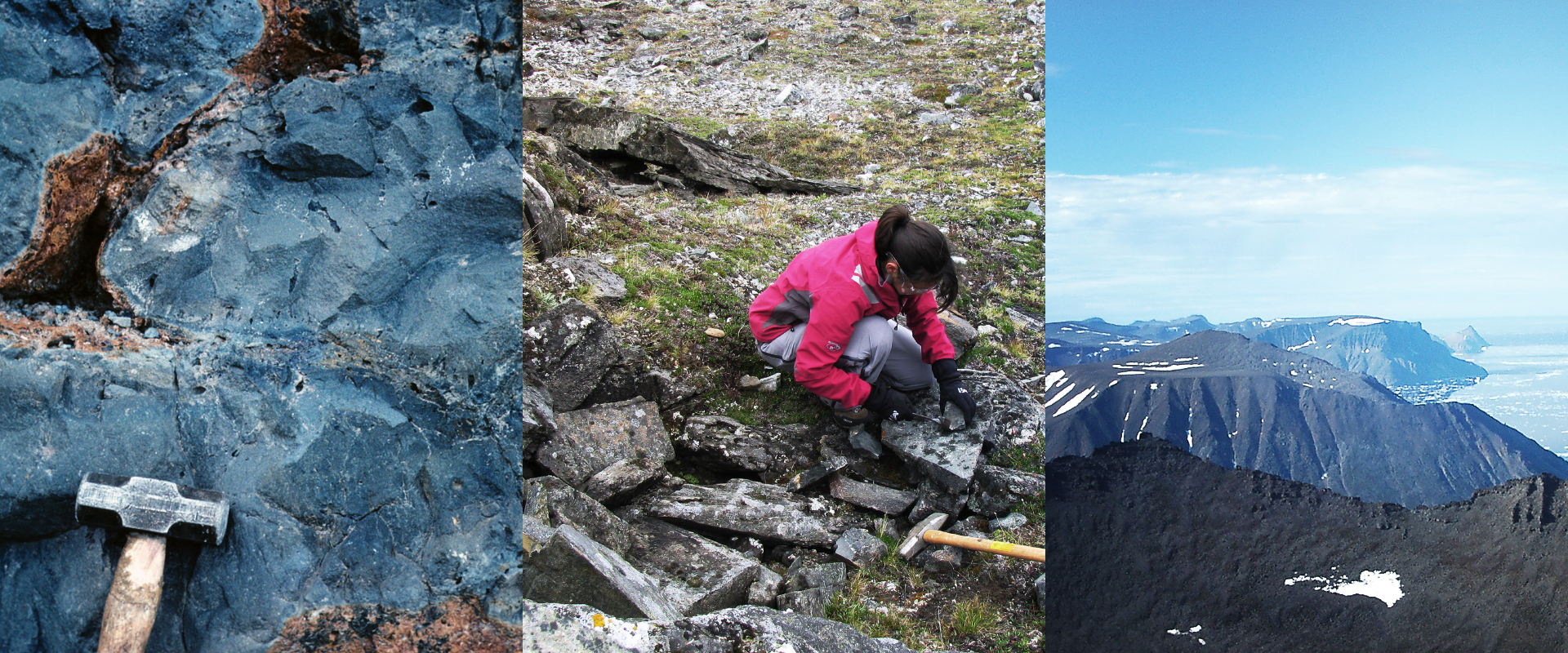
The 60 million-year-old flood basalts of Baffin Bay, Greenland, sampled by the geochemist Hanika Rizo (center) and colleagues, contain isotope traces that originated more than 4.5 billion years ago.
Don Francis (left); courtesy of Hanika Rizo (center and right).
The researchers say they will be able to use tungsten anomalies and other isotope signatures in surface material as tracers of the ancient interior, extrapolating downward and backward into the past to map proto-Earth and reveal how its features took shape. “You’ve got the precision to look and actually see the sequence of events occurring during planetary formation and differentiation,” Carlson said. “You’ve got the ability to interrogate the first tens of millions of years of Earth’s history, unambiguously.”
Anomalies have continued to show up in rocks of various ages and provenances. In May, Hanika Rizo of the University of Quebec in Montreal, along with Walker, Jackson and collaborators, reported in Science the first positive tungsten anomaly in modern rocks — 62 million-year-old samples from Baffin Bay, Greenland. Rizo hypothesizes that these rocks were brought up by a plume that draws from one of the “blobs” deep down near Earth’s core. If the blobs are indeed rich in tungsten-182, then they are not tectonic-plate graveyards as many geophysicists suspect, but instead date to the planet’s infancy. Rizo speculates that they are chunks of the planetesimals that collided to form Earth, and that the chunks somehow stayed intact in the process. “If you have many collisions,” she said, “then you have the potential to create this patchy mantle.” Early Earth’s interior, in that case, looked nothing like the primordial magma ocean pictured in textbooks.
More evidence for the patchiness of the interior has surfaced. At the American Geophysical Union meeting earlier this month, Walker’s group reported a negative tungsten anomaly — that is, a deficit of tungsten-182 relative to tungsten-184 — in basalts from Hawaii and Samoa. This and other isotope concentrations in the rocks suggest the hypothetical plumes that produced them might draw from a primordial pocket of metals, including tungsten-184. Perhaps these metals failed to get sucked into the core during planet differentiation.
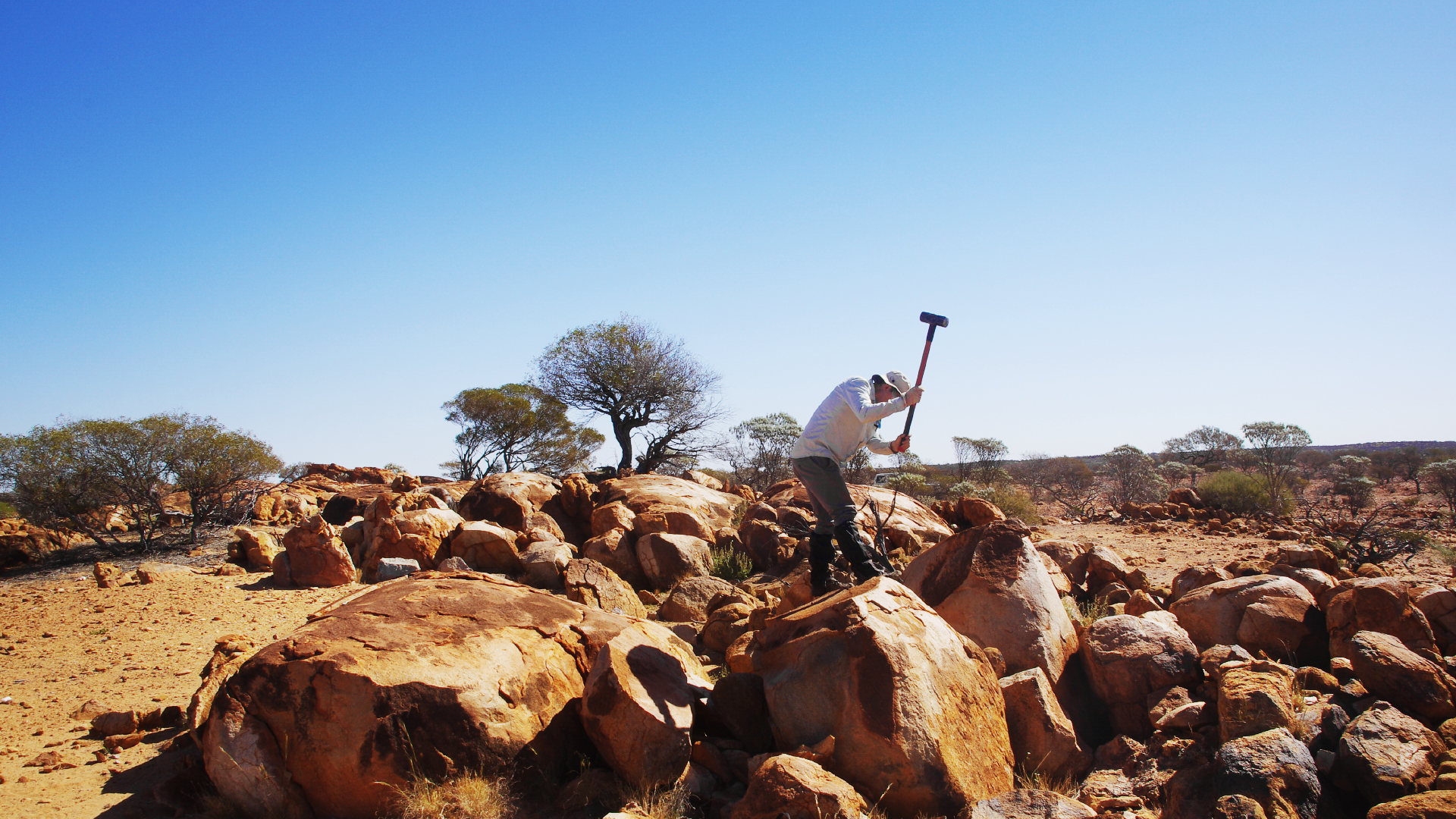
Tim Elliott collecting samples of ancient crust rock in Yilgarn Craton in Western Australia.
Tony Kemp
Meanwhile, Elliott explains the positive tungsten anomalies in ancient crust rocks like his 3.8 billion-year-old Isua samples by hypothesizing that these rocks might have hardened on the surface before the final half-percent of Earth’s mass — delivered to the planet in a long tail of minor impacts — mixed into them. These late impacts, known as the “late veneer,” would have added metals like gold, platinum and tungsten (mostly tungsten-184) to Earth’s mantle, reducing the relative concentration of tungsten-182. Rocks that got to the surface early might therefore have ended up with positive tungsten anomalies.
Other evidence complicates this hypothesis, however — namely, the concentrations of gold and platinum in the Isua rocks match world averages, suggesting at least some late veneer material did mix into them. So far, there’s no coherent framework that accounts for all the data. But this is the “discovery phase,” Carlson said, rather than a time for grand conclusions. As geochemists gradually map the plumes and primordial reservoirs throughout Earth from core to crust, hypotheses will be tested and a narrative about Earth’s formation will gradually crystallize.
Elliott is working to test his late-veneer hypothesis. Temporarily trading his mass spectrometer for a sledgehammer, he collected a series of crust rocks in Australia that range from 3 billion to 3.75 billion years old. By tracking the tungsten isotope ratio through the ages, he hopes to pinpoint the time when the mantle that produced the crust became fully mixed with late-veneer material.
“These things never work out that simply,” Elliott said. “But you always start out with the simplest idea and see how it goes.”
This article was reprinted on TheAtlantic.com.



